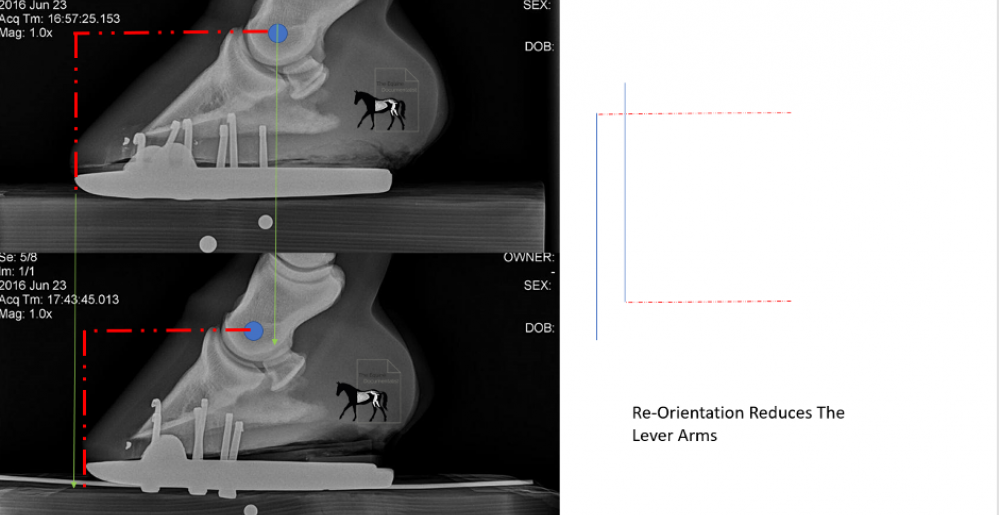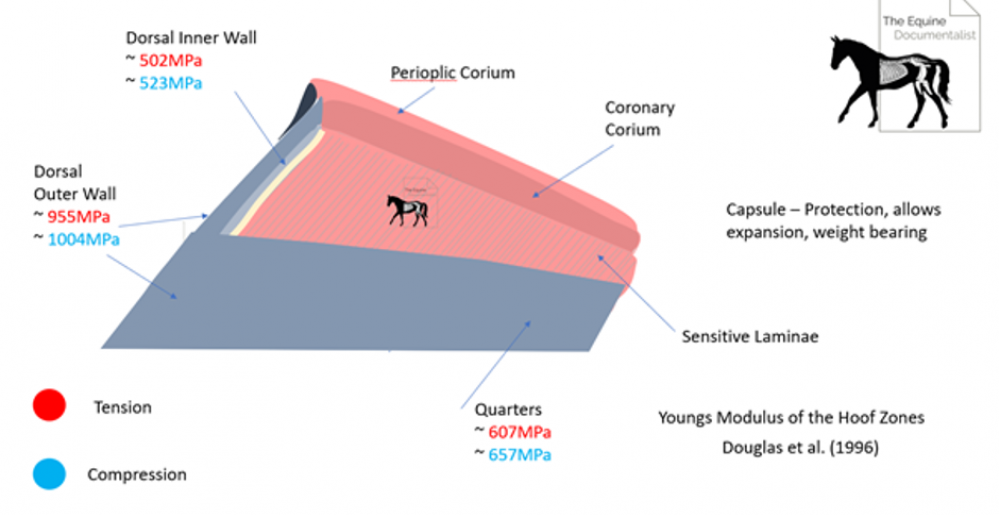
Maintaining capsule integrity for improved morphology
Long toe, low heels are something that every farrier deals with at some point in their daily practice. But are there misconceptions on how to deal with it?
Maintaining capsule integrity for improved morphology
Long toe, low heels are something that every farrier deals with at some point in their daily practice. But are there misconceptions on how to deal with it?

Fig.1 Change in the functional length of the toe by addressing heel to toe height ratios.
It is important in practice to firstly establish if the foot actually has a long (flared/stretched) toe or in fact just has an acutely angled toe due to having low heels, or poor heel to toe height ratio. Fig.1 shows the changes in the functional length of toe and their lever arms with minimal rasping of the dorsal wall, by increasing heel height.
Very often the reality is, the long toe appearance is a fact of poor caudal hoof health. Lack of integrity of the palmar hoof. The answer invariably, therefore, does not lie in removing the integrity of the dorsal wall as well. Don’t rob Peter, to pay Paul!
We know that caudal hoof health is a factor of its function. The weight counteraction, normal hoof distortion (biomechanics) and haemodynamic mechanisms of the palmar hoof structures. A rhetoric repeated through most of my articles. Addressing the caudal hoof health is instead implied, in these cases, when poor dorso-palmar balance is recognised.
But what is the issue with creating better proportions by rasping the dorsal wall to a better angle?
Douglas et al. (fig.2) studied the elastic modulus (strength) of the different areas of the hoof. The lower the elastic modulus, the more deformation it experiences. The more prone to failure it also is. The capsule has different moduli from toe to heel as well as across its cross section.

Fig.2 Douglas et al. (1996) The elastic modulus of the different areas of the hoof. Note that the outer wall is twice as stiff as the inner wall, with the inner wall having a lower modulus than the heels.
This composition of the capsule facilitates its function. It allows for expansion and contraction of the back half of the capsule.

Fig.3 The natural deformation of the hoof, important for shock dispersion, results from the youngs modulus of the different areas of the hoof.
It’s harder wall at the toe protects the underlying structures while its softer internal wall reduces the risk of damage to these same structures during deformation. This architecture, as nature designed it, is what maintains the capsules proportions, by facilitating its natural deformation and efficient shock dispersion.

Fig.3 The capsule has a harder outer wall to address compressive forces and a softer inner wall to protect the underlying soft tissues. The keratin structures also differ through its cross section to address the different types of forces they experience.
The outer hoof wall has a higher concentration of tubula horn to cope with the compressive forces of weight bearing, while the inner wall has a higher concentration of inter-tubula horn, orientated perpendicular to the tubules to cope with the tensile forces transferred from the wall across the laminal bed.
Now consider what happens when the dorsal wall is rasped to expose the softer inner wall. Now the toe is more flexible than the heels! Its ability to cope with compressive forces has been reduced and it will fail (collapse) more readily. We have functionally turned the hoof back to front.
So perhaps we can understand why when you come back to the foot next time, the toe is even longer and more flared. Why the integrity of the capsule, as a whole, suffers and why positive morphology becomes difficult. Because we have affected the functional equilibrium.
Studies have highlighted the importance of the hoofs natural shock dispersion mechanisms, its natural deformation and haemodynamic system, in maintaining its shape. These things are affected by its composition. If we change the composition to create immediately more aesthetic proportions, without addressing the actual issues (robbing Peter to pay Paul) then we affect this shock dispersion mechanism and the hoof intrinsic biomechanics. Restricting our ability to bring about positive morphology.
So how do we address this!? Firstly of course maintain capsular integrity. Then engage the caudal hoof while creating proportions in 3 dimensions.

Fig.4 Genuine positive hoof capsule morphology achieved by addressing the collapsed heels and caudal hoof while minimally rasping the dorsal wall. Note that coming under the toe to create better proportions and “backing the toe up” does not have the same deleterious effects as reducing the dorsal wall thickness.

Fig.5 Re-engagement of caudal hoof structures and creation of 3 dimensional proportions.
In conclusion, to create genuine improvements in hoof capsule proportions we need to build integrity of the structures that are failing and not reduce the integrity of other structures for instant aesthetic gratification!